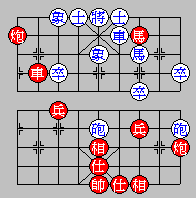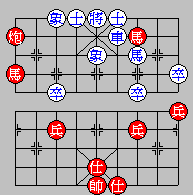19. When a Rook cannot move because of an opponent's Knight,
the Rook cannot be perpetually chased, regardless of whether
the opponent's Knight is protected. (See examples in Diagram
39, 40, and 41)
 Diagram 39: Red (in Capital) moves first
Diagram 39: Red (in Capital) moves first
R8+2 g6+5
R8-3 g5-6
R8+3 g6+5
R8-2 g5-6
R8+2 ....
.
.
 Diagram 40: Red (in Capital) moves first
Diagram 40: Red (in Capital) moves first
C8-1 g5-6
C8-1 g6+5
c8+1 g5-6
c8-5 g6+5
c8+5 ....
.
.
 Diagram 41: Red (in Capital) moves first
Diagram 41: Red (in Capital) moves first
N9+8 g6+5
N8-7 g5-6
N7+6 g6+5
N6-7 g5-6
N7+8 ....
Explanation:
In Diagrams 39, 40, and 41, the Red Knight is not protected but
because the Black Rook doesn't move, it is not considered as a
perpetual chase. On the contrary, each of the Red moves attacks
the Black Rook and this is a violation of the rule. Red has to
change.


